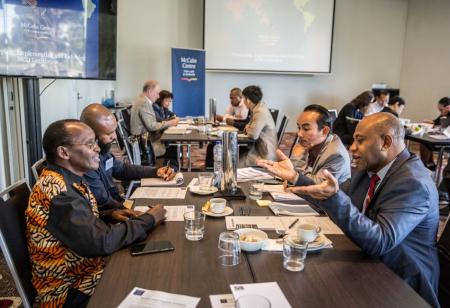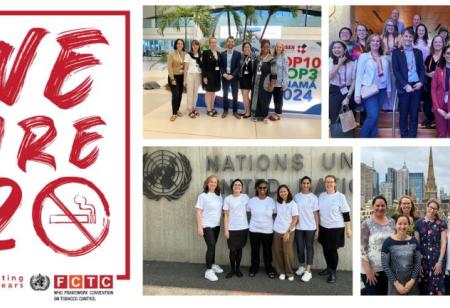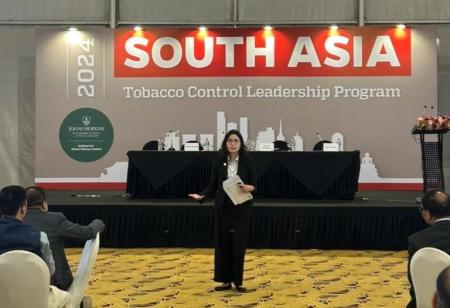
The new Philip Morris-funded Foundation for a Smoke-Free World: independent or not? - 29 January 2018

In his 23 January BMJ blog, ‘Building a Foundation to accelerate an end to smoking’, Derek Yach again defends and promotes his new Philip Morris-funded Foundation for a Smoke-Free World.
It is fair to say that Yach’s new Foundation has not been warmly welcomed by the public health community at large, as evidenced by this selection of responses to the Foundation’s announcement, including from the Secretariat to the WHO Framework Convention on Tobacco Control, the World Health Organization, and leading civil society organizations. Last week, the deans of 17 leading schools of public health announced that their schools would not be accepting funding from or pursuing work with the Foundation.
Yach’s latest blog represents another attempt to defend the ‘independence’ of his new Foundation. It is not hard to understand why Yach should be so preoccupied with trying to defend the Foundation’s independence, given that the Foundation was developed and established as a culmination of a long period of discussion with, and with the support of, the multinational tobacco company Philip Morris, including, most significantly, a conditional 12-year funding commitment of almost USD1billion.
Yach’s blog is interesting not least because it comes after the release of the ‘Pledge Agreement’ setting out the legal relationship between Philip Morris (PMI Global Services Inc.) and the Foundation, including the conditions of Philip Morris’s legal obligation to pay the Foundation ‘Annual Pledges’ of USD80M from January 2018 through to July 2029. The Pledge Agreement Yach has released was signed on 9 January, several months after Yach and Philip Morris announced the establishment of the Foundation and the amount and nature of Philip Morris’s support.
One of the more unusual features of Yach’s repeated assertions of the Foundation’s independence over the last few months has been his claims that its independence could be seen from the Foundation’s constitutive documents, namely its Certificate of Incorporation and Bylaws. The idea that the independence of an organization can be demonstrated by viewing only its constitutive documents, rather than examining, for example, how it came into being, the way it operates, the kinds of agreements and arrangements it comes to with third parties, and the financial and other factors that are relevant to its decision-making, is curious to say the least.
In his BMJ Blog, Yach asserts that the Pledge Agreement ‘legally binds PMI to provide the Foundation with US$80 million annually for 12 years, as long as the Foundation’s independent board of directors certifies annually that it remains focused on ending smoking and addressing the consequences of reduced tobacco use on tobacco farmers’.
Having read the Certificate of Incorporation, Bylaws and Pledge Agreement, I find something different from what Yach describes.
One of the most fundamental matters here is the purpose/s of the Foundation – what is the purpose/s? Who decides? What happens if there is disagreement? Can it / they be changed, and if so, how?
The Foundation’s purposes are set out in Article THIRD of the Certificate of Incorporation, and Article IX, paragraph A of the Bylaws.
Certificate of Incorporation, Article THIRD
The Foundation ‘is organized and shall be operated exclusively for charitable, scientific and educational purposes’ within the meaning of the relevant Delaware law, ‘including, without limitation, to support independent scientific research free from the influence of any commercial entity that may be affected by the research outcome’. ‘In furtherance thereof, but without limitation thereon’ the Foundation is to use its assets and income to:
- ‘make grants and other distributions … to support research and projects regarding alternatives to cigarettes and other combustible products and how best to achieve a smoke-free world and advance the field of tobacco harm reduction’
- ‘fund global research initiatives and publish reports regarding, among other things, the attitudes and opinions of the general public towards tobacco harm reduction’
- ‘fund scientific verification studies to assess the impact of smoke-free and reduced risk products on public health outcomes and how such products affect the general population’
- ‘scrutinize, comment on, and inform the general public regarding the activities of the tobacco industry, other commercial entities and other stakeholders which may have an impact, either positive or negative, on achieving a smoke-free world and advancing the field of tobacco harm reduction’
- ‘research the effect of the reduced demand for leaf tobacco on farmers and other stakeholders and explore and promote sustainable agricultural and nutritional alternatives for tobacco farmers, tobacco land and other stakeholders’
- ‘research sustainability issues and solutions related to the management of smoke-free and reduced risk products-related waste materials’
- ‘conduct global conferences, forums, panels and similar programs to focus on the evolving science regarding alternatives to cigarettes and other combustible tobacco products and how best to realize a smoke-free world’
Bylaws, ARTICLE IX
The Foundation is to be ‘operated consistent with’ the criteria and principles ‘set forth in Article THIRD of the Corporation’s Certificate of Incorporation’, and ‘in a manner that ensures the Corporation’s freedom and independence from the influence of any commercial entity’. Its goal is to ‘promote and support significant research that advances the field of tobacco harm reduction and reduces the public health burden of smoking-related diseases’.
In the event that readers of the documents are unsure that these do indeed constitute the Foundation’s purpose/s, confirmation can be found – of all places – in the first recital paragraph of the Pledge Agreement.
The first thing to be said is that it is at best significantly incomplete to suggest that the Foundation’s purposes (and Philip Morris’s conditional legal obligation to pay the Annual Pledges) are focused on ‘ending smoking’ without saying that the ending of smoking is to be pursued in the context of the use of ‘alternative’ products and ‘harm reduction’. The relevant wording in the Certificate of Incorporation and the Bylaws does not support ‘ending smoking’ through activities aimed at prevention of uptake or cessation of use without replacement by other products. If that had been the intention, it would have been a simple matter to so provide. Patently, Philip Morris has a significant commercial interest in alternative products / harm reduction, whereas prevention of uptake and cessation of use, without replacement by other products, are not in its interests.
At heart, what the arrangement between the Foundation and Philip Morris represents is an attempt to operationalize a perceived intersection between Yach’s ambitions and Philip Morris’s commercial interests that Philip Morris judges to be valuable enough to it to justify an (albeit conditional) USD960 million commitment. The USD960 million is to be spent on certain things only – not things that are obviously inconsistent with Philip Morris’s commercial interests. This – if individuals and organizations are prepared to accept the money on offer – will inherently and significantly recast the field of tobacco control research and practice. Clearly, such a recasting would be of substantial benefit to Philip Morris. To suggest that such an enterprise can be made ‘independent’ through technical governance fixes shows an awareness of a need for the Foundation to address a significant PR challenge, but it seems to rely on a rather hollow understanding of the notion of ‘independence’.
But Philip Morris’s ongoing influence over the Foundation – as long as the Pledge Agreement remains in place – becomes clearer the closer one looks.
According to the Bylaws (Article XIII), both the Certificate of Incorporation and the Bylaws may be amended or repealed, and a new Certificate of Incorporation or Bylaws adopted, upon the affirmative vote of two-thirds of Directors entitled to vote. Such a provision is understandable, as organizations need the freedom to change as circumstances change – though it raises obvious questions about the value of Yach’s claims about the protections provided by the constitutive documents, given that they can be amended, at any time, by two-thirds of the Directors, whoever these come to be. It might be noted here that the ‘independent’ Board of Directors will likely be a group inherently unrepresentative of the fields of tobacco control / public health, as it is hard to imagine that it will include many (or any) individuals unsympathetic to the arrangement Yach has struck with Philip Morris. This rather narrows the field of potential Directors.
It turns out, however, that the Foundation does not in fact enjoy the kind of freedom to change as circumstances change that the Bylaws suggest. Under the Pledge Agreement (Article 3.3(a)(iv)), Philip Morris’s Annual Pledges are payable only if the Foundation has ‘not rescinded, amended or modified the Foundation’s Purpose or its Organizational Documents’ – except that the Foundation may ‘amend or modify its Organizational Documents (other than with respect to the Foundation’s Purpose) provided such amendments or modifications are of a purely administrative nature’.
In other words, the cost of change – for example, to focus on ending smoking other than through alternative products / harm reduction, if two-thirds of the Directors came to believe that this was in the best interests of public health – would be the USD960 million, or at least, depending on when over the course of the 12 years such a change might be contemplated, the balance of the USD960 million not yet paid. Ordinarily, considerations of this nature might be seen to raise questions about the influences that might operate on the minds of Directors. It would be reasonable to see this as an important aspect of the independence of an organization from a funder.
Relatedly, the entire arrangement turns on the Foundation operating in accordance with its purposes. Under Article 3.3(a)(iii), the Annual Pledges are payable by Philip Morris on condition that, in the previous calendar year, the Foundation has ‘operated, and intends to continue operating, exclusively in accordance with the Foundation’s Purpose’. Under Article 3.4(b), Philip Morris is ‘bound in determining’ whether the Foundation is in compliance with this requirement by ‘a unanimous attestation … to that effect’ by the Foundation’s Board of Directors. This is the provision to which Yach alludes in his significantly incomplete statement that the Annual Pledges are payable ‘as long as the Foundation’s independent board of directors certifies annually that it remains focused on ending smoking …’
Yach seems to offer this element of the agreement as evidence of the independence of the Foundation. An alternative way to look at it might be as a powerful mechanism to fully internalize across the Foundation the significance of Philip Morris’s funding, and what Philip Morris is purchasing with its conditional funding, ie the purposes of the agreement as seen from the perspective of Philip Morris. Having to make such an attestation annually – as a condition of receiving Philip Morris’s USD80M – might be expected to focus the minds of the Directors, not just at the time of attestation, but all year round.
Further, it could reasonably be observed that the Pledge Agreement contains even more significant mechanisms for seeking to ensure that the Foundation acts in accordance with Philip Morris’s perspective of the purpose of the Foundation. First, under Article 4.4, the Foundation ‘represents, warrants and covenants that it shall use the Annual Pledges exclusively in furtherance of the Foundation’s Purpose’. Any ‘material failure to comply’ with this provision, which ‘cannot be, or has not been, remedied within 60 days of the Foundation’s receipt of written notice from Pledgor with respect to such failure’ is grounds for termination (under Article 8.1(d)). Underlining the significance of Article 4.4, Article 8.2 specifies that it shall survive termination of the agreement. Second, the entire agreement shall terminate if ‘the Foundation ceases to operate in furtherance of the Foundation’s Purpose’ (Article 8.1(b)). In other words, the whole thing – including the money – is off if the Foundation departs from its purpose.
Just what exactly does and does not fall within the Foundation’s purpose – not in theory, but in terms of significant day-to-day decisions – is thus a rather important matter, one on which Philip Morris may well have strong views. There may well be – whether occasionally or frequently – honest, genuine disagreement between the Foundation and Philip Morris on such a matter. Indeed, it would be alarming if there were not. This is the kind of matter that could find its way to litigation if not capable of being resolved by the Foundation and Philip Morris. But it does not take a lot of imagination to envisage the ways short of litigation – formal and informal, explicit and implicit, blatant and subtle – in which such a funder might communicate to a funding recipient its views on the recipient’s understanding of its purpose, and on whether the recipient’s activities or plans are consistent with the funder’s views.
These kinds of considerations cannot simply be waved away by including a provision in the Foundation’s Bylaws stating that the Foundation shall operate ‘in a manner that ensures [its] freedom and independence from the influence of any commercial entity’ (Article IX). Any decision or action could be claimed to have been taken independently and without influence. How could it ever be proved otherwise? This is why, for example, effective conflict of interest policies address the circumstances and relationships that may affect decision-making, rather than simply deferring to an individual or organisation’s assertion that they have not been, or would not be, influenced by something that others might reasonably perceive may exert some influence upon them. Nor can these considerations be made to disappear by the provision in the Pledge Agreement (Article 2.3) stating that the Foundation ‘shall maintain full independence, free from the control, interim instructions, or influence, whether direct or indirect, from or by’ Philip Morris or others. If the whole relationship is based on conditional funding, it is an absurdity for the agreement that enshrines that relationship to say that the funding recipient must not be influenced, directly or indirectly, by the funder.
Putting all this together, it would not be unreasonable to form a picture which is different from the one Yach sees, one in which Yach’s ‘independent foundation’ is more akin to a program of Philip Morris, with Yach and the Foundation’s Directors, whoever these come to be, having a degree of day-to-day autonomy in their operations (just how much autonomy is unknowable), but with the fundamental settings put in place by, and enforced, by Philip Morris’s USD960 million.
Yach has also said much about the transparent manner in which he and his Foundation are operating. While release of the Certificate of Incorporation, Bylaws and Pledge Agreement is a small start, it would support Yach’s claims to transparency if he were to release all correspondence he and his affiliates have had with Philip Morris (and others) relating to the initiative, and all notes of relevant meetings and calls he has had with Philip Morris, and to do this on an ongoing basis. Of particular interest at this point in time would be correspondence relating to the Certificate of Incorporation, Bylaws and Pledge Agreement, including drafts of these documents (and comments made thereon), and any correspondence that throws light on the curious gap between the announcement of the establishment of the Foundation, including Philip Morris’s 12 September 2017 announcement of support, and the signing of the Pledge Agreement on 9 January 2018. It would also not be too much to ask that Philip Morris release all of its internal documents relating to the initiative including its internal business case for the USD960 million investment, and all documents showing how Philip Morris will monitor, evaluate and review the success of its investment. Again, this should occur on an ongoing basis.
Without such disclosures, claims of transparency should not be credited. Transparency – which is fundamentally about enabling a genuine, informed understanding of what is going on, for what reasons, and to whose benefit – should not be allowed to be confused with publicity.





